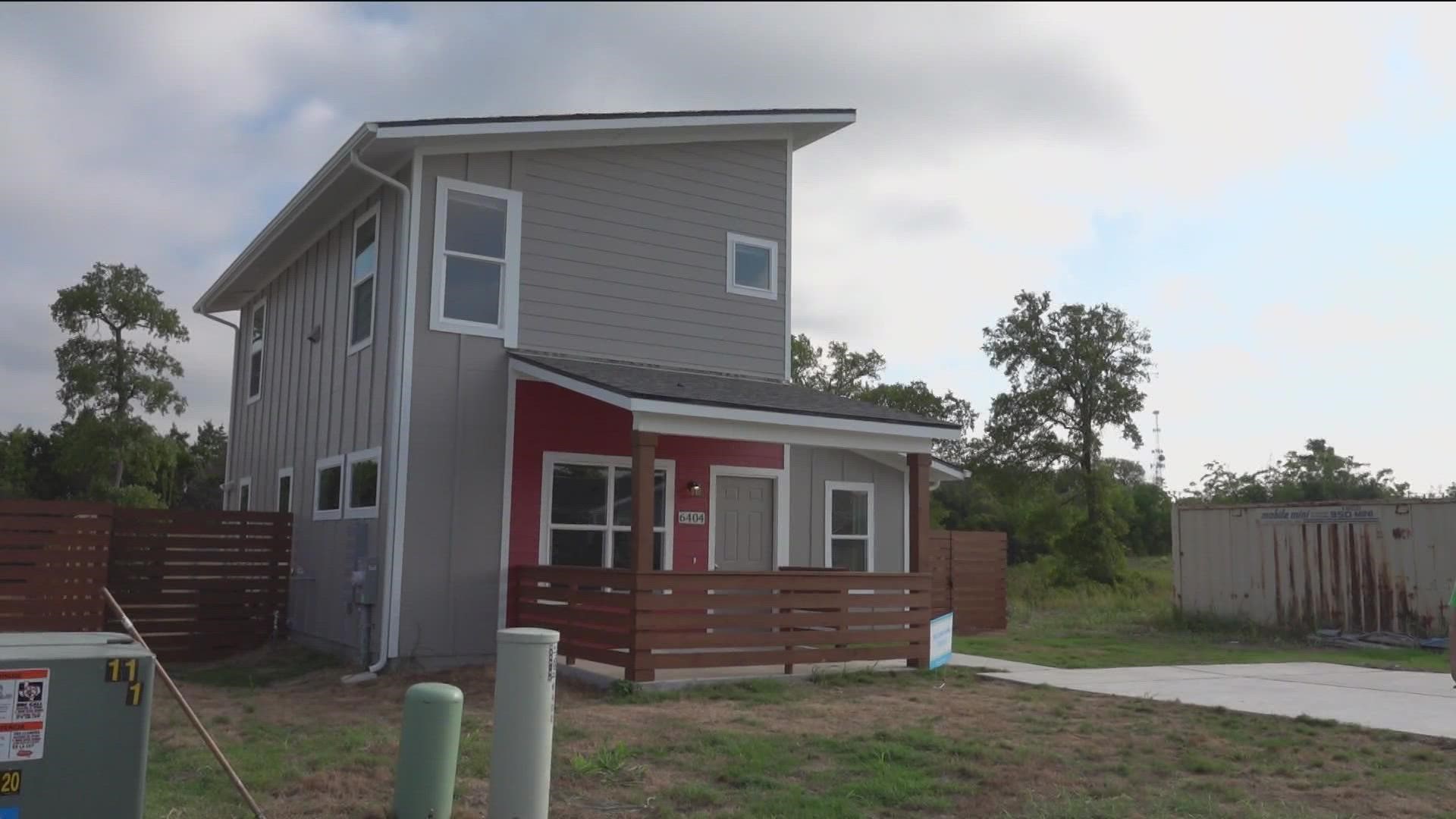AUSTIN, Texas — Austin city leaders want voters to approve a $350 million affordable housing bond. That is nearly all the affordable housing money voters approved in 2006, 2013 and 2018 bonds combined.
The KVUE Defenders looked into how that money has been utilized, how much debt Austin taxpayers carry, and if another round of taxpayer increases from the newly proposed bond would end Austin’s affordability problem.
In a place where affordability is rare, Regina Dright will now grow roots deep enough for her whole family.
“I look forward to her going to college and coming back home and going to her room,” Regina said as she showed us her daughter’s new room, in her new Austin home.
It is a home the single parent of three worked for more than a decade to get. She overcame hearing challenges to get through school, built-up her credit, and saved for a down payment.
Her home was built by Austin Habitat for Humanity, funded in part by Austin’s affordable housing bond dollars.
“It’s wonderful,” she said.
It is one of nearly 120 homes Austin Habitat for Humanity and its subsidiary, Homebase, built in 2022.
Phyllis Snodgrass, CEO of Austin Habitat, said the organization is doing what it can to try and bridge the affordability gap.
“People are making more than they've ever made, but housing costs more than it's ever cost,” said Snodgrass. “And the gap just continues to widen.”
Finance records show Austin Habitat is one of nearly two dozen organizations given money for housing developer assistance under general obligation bonds. The taxpayer dollars help bridge the gap between the cost of building a home and selling it at an affordable price.
“We used to be able to sell housing, you know, for $90,000 a house, and we would finance it with a 0% interest loan,” Snodgrass explained. “And I love that we could do that. But we cannot even get the land for that anymore."
The Texas Real Estate Research Center with Texas A&M University shows the median home price in Austin for September was $470,000. A home at that price is too expensive for someone to qualify for the federal first-time homebuyer program.
Affordable housing bonds, projects in Austin
In the last decade, City finance records show, taxpayers gave Austin Habitat nearly seven million dollars to build affordable housing and make home repairs. Nearly two million of that money came from affordable housing bonds.
In 2006, voters approved a $55 million bond for affordable housing. Then, another $65 million in 2013 and another $250 million in 2018.
The 2006 bond paid for 2,600 housing units, a mix of homes and apartments while about $4.5 million went to home repairs for low-income homeowners.
The 2013 and 2018 bonds combined for a total of 3,707 affordable housing units.
Nearly half, or $100 million, of the 2018 affordable housing bond money went toward buying land and real estate around the city, including nearly 60 acres worth of vacant lots, three hotels, and about 45 single-family homes to renovate and resell through the Community Land Trust.

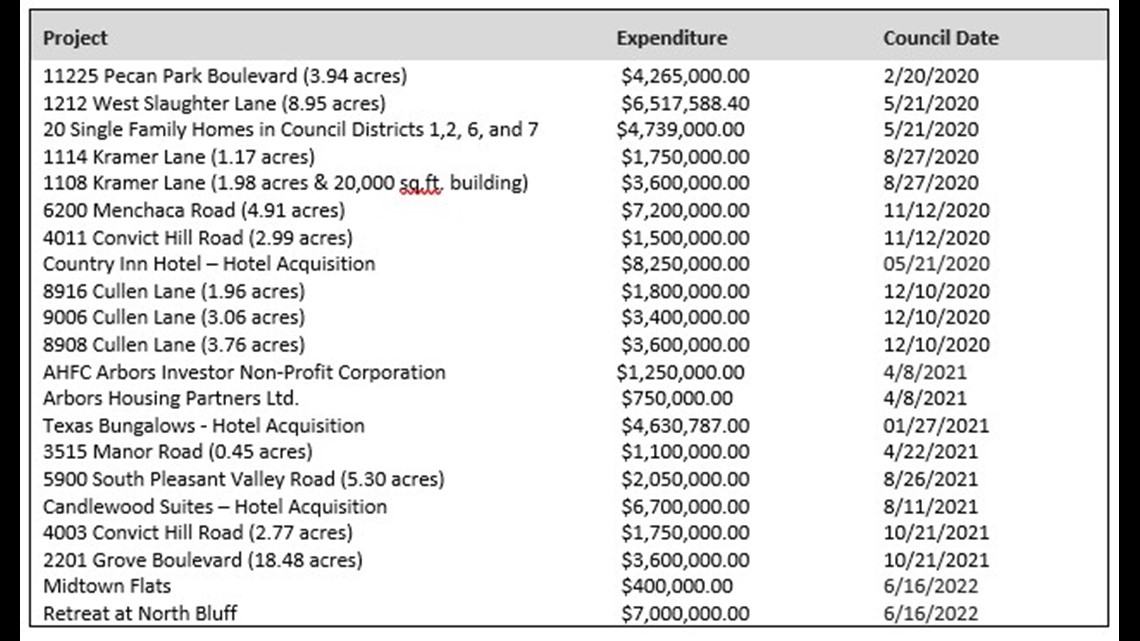
In a February 2022 bond oversight commission meeting, Austin Housing and Planning Department staffers told members part of the affordable housing bond money would run out earlier than planned. Most of the money for land acquisition is no longer available.
“How did we get in the position of running out of authority in one of the most demanded expenditure areas, affordable housing,” one member asked.
The City’s Acting Housing and Community Development Officer, James May, filed a response with the commission showing that the “Council elected to allocate both Year 4 and Year 5 allocations to respond to spending requests more rapidly.”

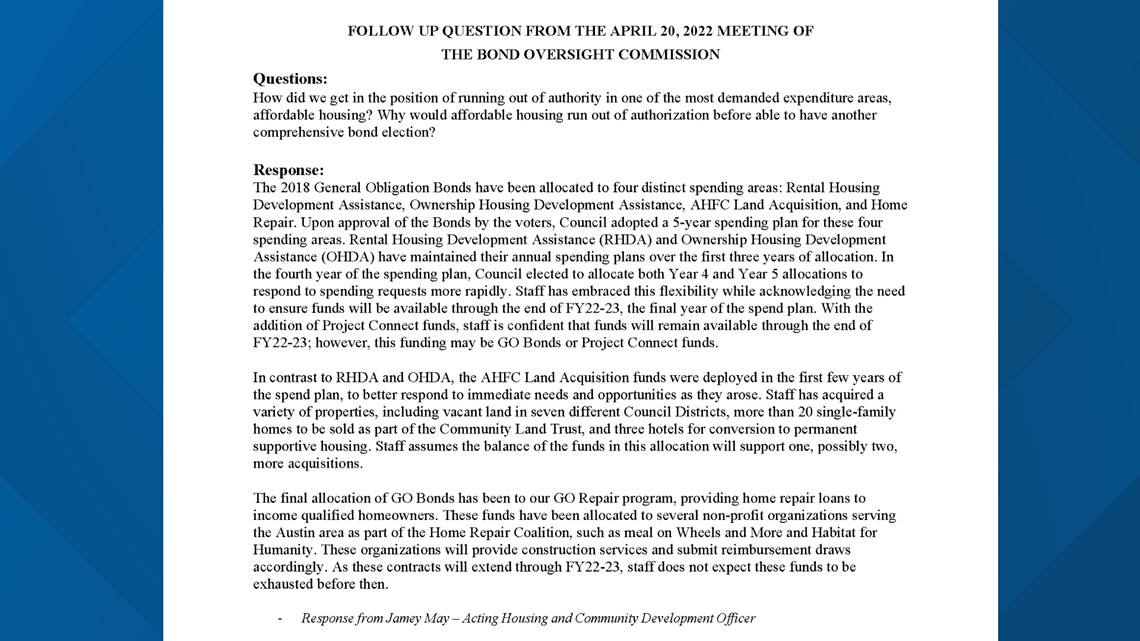
The remaining 2018 bond money, about $34 million, will go to rental housing development, ownership housing development, and home repairs for low-income homeowners.

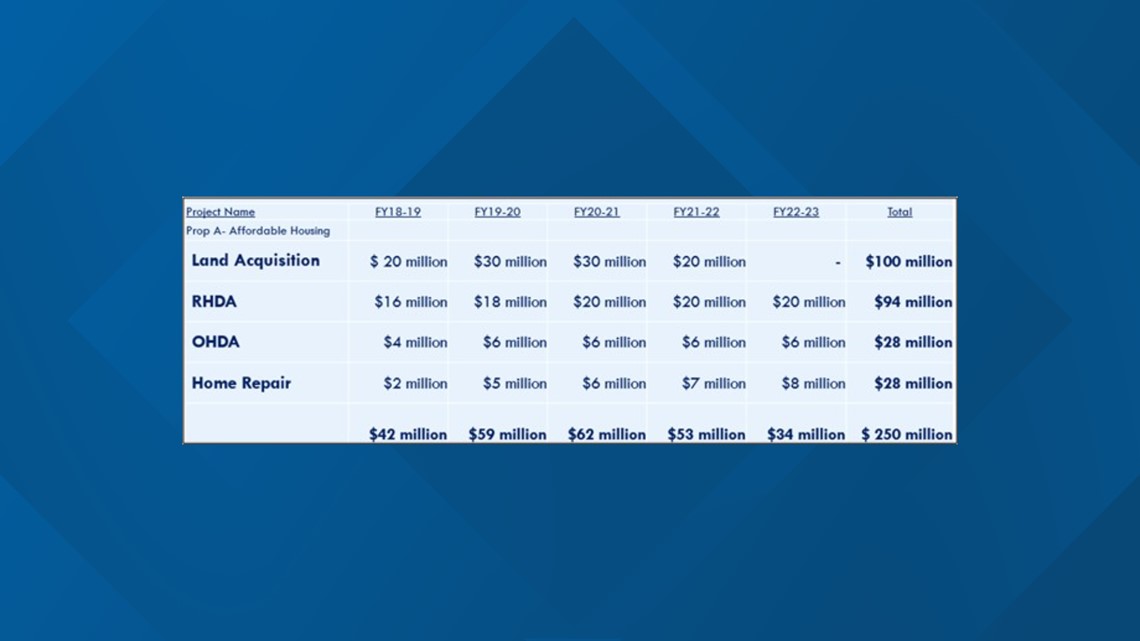
Nearly half of the projects for rental housing are not finished yet. About 15,000 low-income rental units are pending. Some projects, like Espero at Rutland, are under construction. Once all projects are finished, the number of rental units available will more than double the amount now.
The homeownership projects are fewer and slower to build. The city has built between 125 and 150 low-income, single-family homes using the 2018 bond. Records show the rest of the planned 500 homes may not be finished until 2027.
“This is primarily due to the time it takes to construct a single-family detached unit versus the time it takes to construct a multi-family development. Two hundred units on the rental side is a lot quicker than a 200 single-family detached,” May said in the bond oversight meeting.

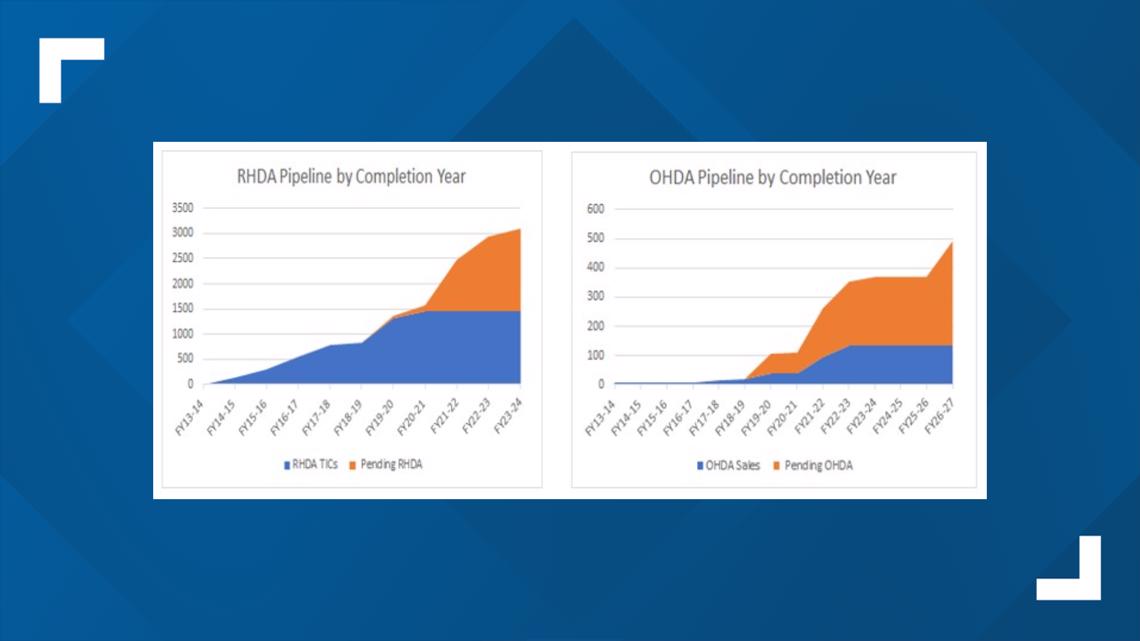
And now city leaders want voters to pass another affordable housing bond worth $350 million, nearly as much as the 2006, 2013 and 2018 bonds combined. If approved by voters on Nov. 8, it will increase Austinite’s tax bill. Right now, more than 20% of taxes paid go to pay off debts associated with all of Austin’s bond projects.
In total, the City is nearly $2 billion dollars in debt. The current debt will carry through 2042.
Solving the affordability problem
After the deadly February 2021 winter storm, the KVUE Defenders showed you a senior living apartment complex built through deals with the City back in the early 2000s that needed repairs. City leaders used 2018 bond money to spend $1.25 million to buy out the investor and then agreed to spend another $750,000 for winter storm repairs.
“Affordable housing is very complicated,” said Austin Housing Development Manager Patrick Russell at the time. “A significant issue with a lot of affordable housing is that the gap between breaking even and making a profit is so narrow that if things go south, a landlord will stop doing upkeep, they'll stop doing ongoing maintenance, and that's the last thing we want,” he continued.
The City buyout added more city oversight.
“We want to put on our 30-year thinking caps and really think about what is needed at year 15, year 30..” said Russell.
Russell now manages the City’s Real Estate Development Division. He told the City’s Arts Commission his department plans to use the 2018 bond money spent on land and acquisitions to “initiate four developments a year.” But all those developments are not yet planned out.
Snodgrass does not believe those developments will be enough to solve Austin’s affordability crisis.
“I don't think we can build our way out of it,” said Snodgrass. “I think we have to build as much as we can possibly build. But the only way we start to solve the problem is thinking differently about what housing looks like and making it more available throughout the community."
Austin’s planning commission may do that. Last week, commissioners said they will vote on an amendment to allow residential buildings in certain commercially zoned areas. City estimates show that change alone could pave the way for nearly 50,000 affordable units.
The planning department staff recommended prohibiting a fee-in-lieu for these areas, something KVUE Defenders told you about two years ago. It allows developers to pay the city a fee instead of providing a percentage of affordable housing units in new housing developments.
Snodgrass wants the new bond proposal to pass.
Austin Habitat homes are sold for about $300,000 or less. But a family must qualify to be able to buy them. Those qualifications include a credit score of 620 or higher, enough money saved for a down payment, and the buyer must not be “cost-burdened” with, ideally, no more than 30% of monthly income going toward payments.
“We can't pump up the price,” Snodgrass told us. “So, it means we need more subsidies to make it work.”
Austin's median family income for a four-person household is $110,300.
The National Association of Realtors website shows a family with that income, and with no debt could afford a mortgage up to $342,000, not the current $470,000 median home price in Austin.
City programs to help
Austin’s CodeNext was intended to simplify the City’s land code, but 19 property owners sued the city in December 2019. Court records show the owners alleged the City failed to provide written notice of a public hearing and did not recognize property owners’ protest rights. The plaintiff owners won in district court in March 2020. The city appealed and lost.
“If it restricts housing, it adds to the cost of housing,” said Snodgrass.
Shortly before the lawsuit against the City over CodeNext, Austin passed “Affordability Unlocked” in 2019 with no public debate. The development bonus program waives or modifies restrictions in exchange for low- and moderate-income housing, which Snodgrass said helps maintain affordable home ownership.
“We put deed restrictions on our homes,” Snodgrass explained. “That house is preserved in the affordable housing market, and they can't sell it to into the regular market.”
Snodgrass said her clients include Austin police officers, firefighters and teachers.
“If you can't find teachers, if you can't get hairdressers in your salons, if you can't get restaurant workers in the restaurants, or waitresses, or you can't get people in the hotels, what kind of community are we going to have?” Snodgrass said.
Meanwhile, Regina Dright plans how to decorate her newly built home. She hopes her story will encourage others to apply for help and hopes that help remains available to others.
“We all should be able to share that…the good life, the good American Dream,” she said. “We should all have that possibility.”
PEOPLE ARE ALSO READING:

